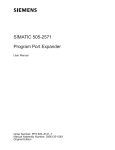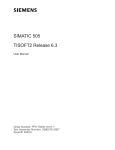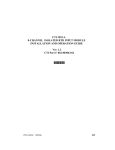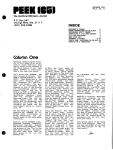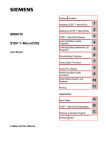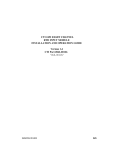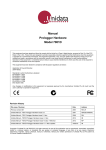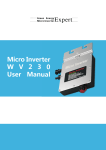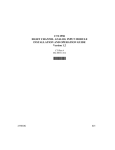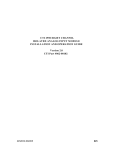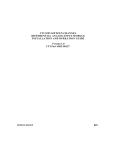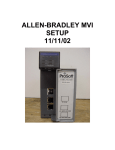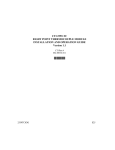Download CTI 2451 EIGHT CHANNEL THERMOCOUPLE INPUT
Transcript
CTI 2451 EIGHT CHANNEL THERMOCOUPLE INPUT MODULE INSTALLATION AND OPERATION GUIDE Version 1.2 CTI Part #062-00111 2451IOG 051403 $25 Copyright © 2003 Control Technology Inc. All rights reserved. This manual is published by Control Technology Inc., 5734 Middlebrook Pike, Knoxville, TN 37921. This manual contains references to brand and product names which are tradenames, trademarks, and/or registered trademarks of Control Technology Inc. Siemens® and SIMATIC® are registered trademarks of Siemens AG. Other references to brand and product names are tradenames, trademarks, and/or registered trademarks of their respective holders. DOCUMENT DISCLAIMER STATEMENT Every effort has been made to ensure the accuracy of this document; however, errors do occasionally occur. CTI provides this document on an "as is" basis and assumes no responsibility for direct or consequential damages resulting from the use of this document. This document is provided without express or implied warranty of any kind, including but not limited to the warranties of merchantiblility or fitness for a particular purpose. This document and the products it references are subject to change without notice. If you have a comment or discover an error, please call us toll-free at 1-800-537-8398. ii CTI 2451 Installation and Operation Guide PREFACE This Installation and Operation Guide provides installation and operation instructions for the CTI 2451 Eight Channel Thermocouple Input Module for SIMATIC® 405 programmable controllers. We assume you are familiar with the operation of SIMATIC® 405 Series programmable controllers. Refer to the appropriate SIMATIC® user documentation for specific information on the SIMATIC® 405 programmable controllers and I/O modules. This Installation and Operation Guide is organized as follows: Chapter 1 provides a description of the module. Chapter 2 covers installation and wiring. Figure 1 The Model 2451 Thermocouple Input Module Chapter 3 is a guide to troubleshooting. CTI 2451 Installation and Operation Guide iii iv CTI 2451 Installation and Operation Guide USAGE CONVENTIONS NOTE: Notes alert the user to special features or procedures. CAUTION: Cautions alert the user to procedures which could damage equipment. WARNING: Warnings alert the user to procedures which could damage equipment and endanger the user. CTI 2451 Installation and Operation Guide v vi CTI 2451 Installation and Operation Guide TABLE OF CONTENTS PREFACE . . . . . . . . . . . . . . . . . . . . . . . . . . . . . . . . . . . . . . . . . . . . . . . . . . . . . . . . . . . . . . . . . . . . . . . . . . iii USAGE CONVENTIONS . . . . . . . . . . . . . . . . . . . . . . . . . . . . . . . . . . . . . . . . . . . . . . . . . . . . . . . . . . . . v TABLE OF FIGURES . . . . . . . . . . . . . . . . . . . . . . . . . . . . . . . . . . . . . . . . . . . . . . . . . . . . . . . . . . . . . . . . ix CHAPTER 1. DESCRIPTION . . . . . . . . . . . . . . . . . . . . . . . . . . . . . . . . . . . . . . . . . . . . . . . . . . . . . . . . . 1.1 Asynchronous Operation . . . . . . . . . . . . . . . . . . . . . . . . . . . . . . . . . . . . . . . . . . . . . . . . . . . . 1.1.1 Active Channels . . . . . . . . . . . . . . . . . . . . . . . . . . . . . . . . . . . . . . . . . . . . . . . . . . 1.2 Type "J" or Type "K" Thermocouple . . . . . . . . . . . . . . . . . . . . . . . . . . . . . . . . . . . . . . . . . . 1.3 Digital Word Map . . . . . . . . . . . . . . . . . . . . . . . . . . . . . . . . . . . . . . . . . . . . . . . . . . . . . . . . . 1.4 Thermocouple Input to Digital Conversion . . . . . . . . . . . . . . . . . . . . . . . . . . . . . . . . . . . . . . 1.5 Effect of Out-of Range Input Signals . . . . . . . . . . . . . . . . . . . . . . . . . . . . . . . . . . . . . . . . . . 1.6 Resolution . . . . . . . . . . . . . . . . . . . . . . . . . . . . . . . . . . . . . . . . . . . . . . . . . . . . . . . . . . . . . . . 1 1 1 2 2 3 3 4 CHAPTER 2. INSTALLATION . . . . . . . . . . . . . . . . . . . . . . . . . . . . . . . . . . . . . . . . . . . . . . . . . . . . . . . 2.1 Planning the Installation . . . . . . . . . . . . . . . . . . . . . . . . . . . . . . . . . . . . . . . . . . . . . . . . . . . . 2.2 Calculating the I/O Base Power Budget . . . . . . . . . . . . . . . . . . . . . . . . . . . . . . . . . . . . . . . . 2.3 Unpacking the Module . . . . . . . . . . . . . . . . . . . . . . . . . . . . . . . . . . . . . . . . . . . . . . . . . . . . . 2.4 Configuring the Module . . . . . . . . . . . . . . . . . . . . . . . . . . . . . . . . . . . . . . . . . . . . . . . . . . . . . 2.4.1 Select Millivolt or Temperature Input . . . . . . . . . . . . . . . . . . . . . . . . . . . . . . . . . . 2.4.2 Selecting Type "J" or Type "K" Thermocouple Inputs . . . . . . . . . . . . . . . . . . . . . 2.4.3 Selecting Digital Filtering . . . . . . . . . . . . . . . . . . . . . . . . . . . . . . . . . . . . . . . . . . . 2.4.4 Select Degrees Fahrenheit or Celsius . . . . . . . . . . . . . . . . . . . . . . . . . . . . . . . . . . 2.5 Inserting the Module into the I/O Base . . . . . . . . . . . . . . . . . . . . . . . . . . . . . . . . . . . . . . . . . 2.6 Wiring the Input Connectors . . . . . . . . . . . . . . . . . . . . . . . . . . . . . . . . . . . . . . . . . . . . . . . . . 2.6.1 Wiring Guidelines . . . . . . . . . . . . . . . . . . . . . . . . . . . . . . . . . . . . . . . . . . . . . . . . . 2.6.2 Wiring Examples . . . . . . . . . . . . . . . . . . . . . . . . . . . . . . . . . . . . . . . . . . . . . . . . . . 2.7 I/O Configuration and Input Format . . . . . . . . . . . . . . . . . . . . . . . . . . . . . . . . . . . . . . . . . . . 2.7.1 Octal Numbering . . . . . . . . . . . . . . . . . . . . . . . . . . . . . . . . . . . . . . . . . . . . . . . . . . 2.7.2 Input Format . . . . . . . . . . . . . . . . . . . . . . . . . . . . . . . . . . . . . . . . . . . . . . . . . . . . . 2.7.3 Operating the Module . . . . . . . . . . . . . . . . . . . . . . . . . . . . . . . . . . . . . . . . . . . . . . 2.8 Decoding Channels . . . . . . . . . . . . . . . . . . . . . . . . . . . . . . . . . . . . . . . . . . . . . . . . . . . . . . . . 2.9 Checking Module Operation . . . . . . . . . . . . . . . . . . . . . . . . . . . . . . . . . . . . . . . . . . . . . . . . . 5 5 5 5 6 7 7 7 8 8 8 9 10 12 12 12 13 14 15 CHAPTER 3. TROUBLESHOOTING . . . . . . . . . . . . . . . . . . . . . . . . . . . . . . . . . . . . . . . . . . . . . . . . . . 17 SPECIFICATIONS . . . . . . . . . . . . . . . . . . . . . . . . . . . . . . . . . . . . . . . . . . . . . . . . . . . . . . . . . . . . . . . . . . 19 LIMITED PRODUCT WARRANTY . . . . . . . . . . . . . . . . . . . . . . . . . . . . . . . . . . . . . . . . . . . . . . . . . . . 23 REPAIR POLICY . . . . . . . . . . . . . . . . . . . . . . . . . . . . . . . . . . . . . . . . . . . . . . . . . . . . . . . . . . . . . . . . . . . 25 CTI 2451 Installation and Operation Guide vii viii CTI 2451 Installation and Operation Guide TABLE OF FIGURES Figure 1 The Model 2451 Thermocouple Input Module . . . . . . . . . . . . . . . . . . . . . . . . . . . . . . . . . . . . . . iii Figure 2 Active Channels . . . . . . . . . . . . . . . . . . . . . . . . . . . . . . . . . . . . . . . . . . . . . . . . . . . . . . . . . . . . . 1 Figure 3 Word Map . . . . . . . . . . . . . . . . . . . . . . . . . . . . . . . . . . . . . . . . . . . . . . . . . . . . . . . . . . . . . . . . . 2 Figure 4 Example Change in Input Level . . . . . . . . . . . . . . . . . . . . . . . . . . . . . . . . . . . . . . . . . . . . . . . . 3 Figure 5 Effect of Temperature Input on Module Performance . . . . . . . . . . . . . . . . . . . . . . . . . . . . . . . 3 Figure 6 Effect of Voltage Input on Module Performance . . . . . . . . . . . . . . . . . . . . . . . . . . . . . . . . . . . 4 Figure 7 Input Resolution . . . . . . . . . . . . . . . . . . . . . . . . . . . . . . . . . . . . . . . . . . . . . . . . . . . . . . . . . . . . 4 Figure 8 Jumper Locations . . . . . . . . . . . . . . . . . . . . . . . . . . . . . . . . . . . . . . . . . . . . . . . . . . . . . . . . . . . 6 Figure 9 Factory Configuration Jumper Settings . . . . . . . . . . . . . . . . . . . . . . . . . . . . . . . . . . . . . . . . . . 7 Figure 10 Screw Terminal Block Wiring . . . . . . . . . . . . . . . . . . . . . . . . . . . . . . . . . . . . . . . . . . . . . . . . . 8 Figure 11 Thermocouple Wiring Example . . . . . . . . . . . . . . . . . . . . . . . . . . . . . . . . . . . . . . . . . . . . . . . . 10 Figure 12 Millivolt Wiring Example . . . . . . . . . . . . . . . . . . . . . . . . . . . . . . . . . . . . . . . . . . . . . . . . . . . . 11 Figure 13 Unused Bits . . . . . . . . . . . . . . . . . . . . . . . . . . . . . . . . . . . . . . . . . . . . . . . . . . . . . . . . . . . . . . . 12 Figure 14 Active Channel Bits . . . . . . . . . . . . . . . . . . . . . . . . . . . . . . . . . . . . . . . . . . . . . . . . . . . . . . . . . 12 Figure 15 Data Word . . . . . . . . . . . . . . . . . . . . . . . . . . . . . . . . . . . . . . . . . . . . . . . . . . . . . . . . . . . . . . . . 13 Figure 16 Example Measurement . . . . . . . . . . . . . . . . . . . . . . . . . . . . . . . . . . . . . . . . . . . . . . . . . . . . . . 13 Figure 17 Ladder Diagram Example . . . . . . . . . . . . . . . . . . . . . . . . . . . . . . . . . . . . . . . . . . . . . . . . . . . . 14 CTI 2451 Installation and Operation Guide ix x CTI 2451 Installation and Operation Guide CHAPTER 1. DESCRIPTION The Model 2451 Eight Channel Thermocouple Input Module is a member of Control Technology's family of I/O modules compatible with the SIMATIC® 405 Series programmable controllers. The Model 2451 is designed to translate Type "J" thermocouples, Type "K" thermocouples and millivolt input signals into equivalent digital words which are then sent to the programmable controller (PLC). The Model 2451 Thermocouple Input Module features built-in cold junction compensation for each thermocouple input. Support for other thermocouple types is available through special request from the factory. Call CTI at 1-800-537-8398 to determine if support is available for your special thermocouple type. 1.1 Asynchronous Operation The module operates asynchronously with the CPU. That is, the update times of the CPU and module do not occur simultaneously. The module converts all selected thermocouple inputs in one module update (which is less than 3.0 milliseconds per selected channel), and stores the digital information in a buffer. 1.1.1 Active Channels One of the channels is considered to be active during each CPU scan. On any given CPU scan, both an indicator describing which channel is active and the information for the active channel is transferred from the module to the CPU. Following the transfer, the channel is deactivated and the next selected channel automatically becomes active. The next CPU scan triggers the active channel indicator and data for this channel and sends it to the CPU; this process repeats. Eight CPU scans are required to obtain data from all eight channels. Thus, although the module itself performs conversion asynchronously with the CPU, the transmission of data from the module to the CPU is asynchronous with the CPU scan. This process is illustrated in the following figure. Figure 2 Active Channels CTI 2451 Installation and Operation Guide 1 The module appears to the controller as 32 X inputs. The module can be installed in any slot of any Series 405 base. Since the Series 405 CPU supports 320 total X inputs, a maximum of 10 thermocouple input modules (80 channels) can be installed in a single Series 405 system. 1.2 Type "J" or Type "K" Thermocouple Each of the module's eight channels may be configured to receive either a Type "J" Thermocouple or a Type "K" non-grounded thermocouple input signal. The module may also be configured to receive DC voltage signals ranging from 0 to 55 millivolts. Selection of Type "J" or Type "K" thermocouples or millivolts are made via internal switch and jumper settings (see Sections 2.4.1 and 2.4.3). 1.3 Digital Word Map Since the module requires a 32-bit input word, the temperature/millivolt data value is placed into the lower 16-bits (bits 0-17 octal) for transmittal to the PLC (as a V-memory location). As shown in the following figure, bit 17 is not used for the data value and is always 0. The LSB (bit 0) is used to note values which are "overrange". The first 8 bits (20-27 octal) of the upper 16 bits are used for channel status and are read as X values. Bits 30-37 (octal) are not used. Figure 3 Word Map 2 CTI 2451 Installation and Operation Guide 1.4 Thermocouple Input to Digital Conversion The following equations may be used to calculate the digital word in decimal format which will result from a particular thermocouple input: Thermocouple Mode, Digital Word (bits 0-17) = Degrees X10 Millivolt Mode, Digital Word (bits 0-17) = Millivolts X100 As an example, the following figure illustrates the effects of a change in input level going from 3.2 degrees to 102.4 degrees in the Thermocouple Input Mode. Figure 4 Example Change in Input Level 1.5 Effect of Out-of Range Input Signals Thermocouple inputs exceeding the ANSI standard of 760 degrees C for Type "J" or 1372 degrees C for Type "K" will cause the overrange bit to be set. A maximum temperature of 761 degrees C for Type "J" or 1373 degrees C for Type "K" will be returned to the PLC for any positive overrange input. Similarily an input below 0 degrees C for Type "J" or 0 degrees C for Type "K" will cause the overrange bit to be set. A temperature of 0.1 degree C will be returned to the PLC for Type "J" and Type "K". Figure 5 Effect of Temperature Input on Module Performance CTI 2451 Installation and Operation Guide 3 Millivolt inputs exceeding 55.00 millivolts will cause the overrange bit to be set. A reading of 55.01 millivolts will be returned to the PLC for any positive overrange input. Similarly a millivolt input below 0 millivolts will cause the overrange bit to be set. A reading of 0.01 millivolt will be returned to the PLC for any negative input. Figure 6 Effect of Voltage Input on Module Performance 1.6 Resolution The module has a resolution of approximately 0.2 degrees C, 0.4 degrees F or exactly 0.02 millivolts. The chart below shows the corresponding input resolution for each of the input configuration modes: Figure 7 Input Resolution 4 CTI 2451 Installation and Operation Guide CHAPTER 2. INSTALLATION The installation of the Eight Channel Thermocouple Input Module involves the following steps: 1. Planning the installation 2. Configuring the module 3. Inserting the module into the I/O base 4. Wiring the module input connector 5. Checking module operation The steps listed above are explained in detail in the following pages. 2.1 Planning the Installation Planning is the first step in the installation of the module. This involves calculating the I/O base power budget and routing the input signal wiring to minimize noise. The following sections discuss these important considerations. 2.2 Calculating the I/O Base Power Budget The Model 2451 requires 2.8 watts of +5V power from the I/O base. Use this figure to verify that the base power supply capacity is not exceeded. 2.3 Unpacking the Module Open the shipping carton and remove the special anti-static bag which contains the module. After discharging any static build-up, remove the module from the anti-static bag. Do not discard the anti-static bag. You will need it for the following configuration procedure. CTI 2451 Installation and Operation Guide 5 2.4 Configuring the Module The Model 2451 must be configured for Type "J" or Type "K" non-grounded thermocouples or millivolt range and digital filtering/no filtering mode before wiring the input connectors and inserting the module into the I/O base. As shipped, all input channels are configured Type "J", thermocouples, degrees Celsius and digital filtering enabled (see Figure 8). Changing the module input channel configuration involves the following steps: 1. Select millivolt or temperature input 2. Selecting Type "J" or Type "K" thermocouple input mode for each channel 3. Selecting digital filtering or no filtering for the module 4. Logging the configuration jumper settings for future reference Each of these steps is described in the following sections. CAUTION: DO NOT attempt to calibrate. Figure 8 Jumper Locations 6 CTI 2451 Installation and Operation Guide 2.4.1 Select Millivolt or Temperature Input Locate jumper JP36 (MILLIVOLT/TEMP jumper in Figure 8) on the 2451 card. Select either Millivolts or Temperature for the module by positioning the jumper in MILLIVOLT or TEMP position. In the millivolt mode, jumpers JP1-16, JP35 and DIP switch SW1 are ignored by the 2451. 2.4.2 Selecting Type "J" or Type "K" Thermocouple Inputs Select the cold junction compensation for each channel by selecting the correct jumper (JP1-16) for each channel. Select the correct linearization table by locating by DIP switch 1 (SW1 in Figure 8) on the 2451 circuit card and select either Type "J" or Type "K" thermocouple for each of the eight inputs by moving each switch to the proper position. The "ON" position corresponds to Type "J" thermocouple input. 2.4.3 Selecting Digital Filtering Locate the Digital Filtering Jumper JP34 (see Figure 8). To enable digital filtering, set the jumper in the ENABLED position. Since many analog input signals contain noise, CTI recommends using digital filtering unless maximum response time is required. Figure 9 Factory Configuration Jumper Settings CTI 2451 Installation and Operation Guide 7 2.4.4 Select Degrees Fahrenheit or Celsius Locate the temperature scaling jumper JP35 on the left hand side of the module (see Figure 8) and select either degrees Fahrenheit or Celsius by positioning the jumper in the FAHRENHEIT or CELSIUS position. 2.5 Inserting the Module into the I/O Base Insert the module into the I/O base by carefully pushing the module into the slot. When the module is fully seated in the slot, tighten the captive screws at the top and bottom to hold the module in place. To remove the module from the I/O base, loosen the captive screws, then remove the module from the I/O base. Be careful not to damage the connector at the back of the module when inserting or removing the module. 2.6 Wiring the Input Connectors Thermocouple input signals are accepted through a screw terminal connector block located on the front of the module. Consult the thermocouple manufacturer's recommendations for selecting the input wire Figure 10 Screw Terminal Block Wiring type and size. 8 CTI 2451 Installation and Operation Guide All GND terminals on the 2451 terminal block (see Figure 10) are common to each other. They are provided as a convenient termination point for cable shields. All input terminals are isolated from the PLC up to 1500VDC. CAUTION: Only non-grounded thermocouples are to be used. 2.6.1 Wiring Guidelines To avoid noise problems, follow these guidelines when installing the module. ! Use the shortest possible wires. ! Avoid placing signal wires parallel to high-energy wires. If the two must meet, cross them at right angles. ! Avoid bending the wire into sharp angles. ! Use wireways for wire routing. ! When using shielded wires, ground them only at the module end for better noise immunity. ! Place wires so that they do not interfere with existing wire. CTI 2451 Installation and Operation Guide 9 2.6.2 Wiring Examples The following example demonstrates hooking up two thermocouples to channels 1 and 2 of the 2451. NOTE: All unused channels should be shorted from the + to the - terminals to prevent saturation of the input amplifier. Failure to do so will result in erroneous readings on adjacent channels. Figure 11 Thermocouple Wiring Example The shields of both thermocouples are connected to terminal 3 GND connector. 10 CTI 2451 Installation and Operation Guide The following example demonstrates hooking up two millivolt inputs to channels 1 and 2 of the 2451. NOTE: The - terminal incorporates cold junction compensation and is not used on millivolt inputs. NOTE: All unused channels should be shorted from the + to the - terminals to prevent saturation of the input amplifier. Failure to do so will result in erroneous readings on adjacent channels. Figure 12 Millivolt Wiring Example CTI 2451 Installation and Operation Guide 11 2.7 I/O Configuration and Input Format 2.7.1 Octal Numbering Series 405 I/O references are numbered in octal (also known as base 8). In octal, the digits 8 and 9 are not used. I/O points are counted as usual from 0 up to 7. Since 8 and 9 are not used, the next point after 7 is 10. When the count reaches 17, the next point is 20. The point following 77 is 100. 2.7.2 Input Format The module appears to the controller as 32 X inputs. To allow the automatic I/O configuration to reserve points X0 through X37 for the module (for a total of 32 points), install the module in the first slot of the first base. The module reserves points Xn through Xn + 37 (octal), where n is the starting point number. These 32 X inputs or bits are defined as shown in Figure 13, which also shows the most significant bit (MSB) and the least significant bit (LSB). As shown in Figure 13, the eight highest X locations (Xn + 30 through Xn + 37) are not used by this Figure 13 Unused Bits module. The next highest eight bits (Xn + 20 through Xn + 27) are used by the module to indicate the active channel (as shown in Figure 14). The data bits from one channel and only one channel are transferred to Figure 14 Active Channel Bits the CPU with each CPU scan. The active channel indicators indentify which channel corresponds to those data bits. 12 CTI 2451 Installation and Operation Guide CTI 2451 Installation and Operation Guide 13 Data bits Xn + 1 through Xn + 16 contain the temperature data of the active channel. Data bit Xn +0 is the overrange bit. Data bit Xn + 17 is not used (see Figure 13). Figure 15 Data Word 2.7.3 Operating the Module For example, the 32 bits given in Figure 15 might be read by the CPU during a scan. Since Xn + 23 contains a 1, channel 4 is active. Thus, the data given in bits Xn + 0 through Xn + 16 belong to channel 4. Data bits 7, 4, and 3 contain a 1, so the data value would be (128 + 16 + 8) 152 and the temperature would be 15.2 degrees (or millivolts range would be 1.52 millivolts). The active channel is automatically incremented to the next selected channel with each CPU scan. The conversion of the analog signals to digital data is asynchronous with the CPU. However, the transfer of data from the module to the CPU is synchronous with the CPU scan. That is, the selected channels are presented to the CPU one at a time (one per CPU scan) in a cyclic fashion. Figure 16 Example Measurement 14 CTI 2451 Installation and Operation Guide 2.8 Decoding Channels Since data from all channels are multiplexed into a single word, you might wish to write a program to decode the information for each channel, as shown in the following figure. This program decodes information from the eight channels and stores it in V-memory. Channel 1 is stored in V2000, channel 2 in V2001, etc. This program assumes the module is configured as X0-X37. X0-X17 can be read as V-memory location 40400. Refer to the memory map in the Series 405 User Manual for details. NOTE: Only one channel is accessed per CPU scan. The active channel is incremented to the next selected channel following each CPU scan. Figure 17 Ladder Diagram Example CTI 2451 Installation and Operation Guide 15 2.9 Checking Module Operation First turn on the base supply power. If the module diagnostics detect no problems, the status indicator on the front of the module will light. If the status indicator does not light (or goes out during operation), the module has detected a failure. For information on viewing failed module status, refer to your SIMATIC® TISOFT user manual. To diagnose and correct a module failure, refer to troubleshooting. You must also check that the module is configured in the memory of the PLC. This is important because the module will appear to be functioning regardless of whether it is communicating with the PLC. To view the PLC memory configuration chart listing all slots on the base and the inputs or outputs associated with each slot, refer to your SIMATIC® TISOFT Programming Manual. An example chart is shown in the following figure. In this example, the 2451 module is inserted in slot 0 in I/O base 0. Data for all channels appears in Vmemory location V40400. See Section 2.8 for a sample program to decode the data for individual channels. If 32 point input module appears on this line, then the module is registered in the PLC memory and the module is ready for operation. I/O MODULE DEFINITION FOR BASE . . . . . 0 SLOT ADDRESS IN OUT 0 . . . . . . . 0000A (435) : 32 PT INPUT MOD 1 . . . . . . . 0000A (435) : EMPTY I/O SLOT 2 . . . . . . . 0000A (435) : EMPTY I/O SLOT 3 . . . . . . . 0000A (435) : EMPTY I/O SLOT 4 . . . . . . . 0000A (435) : EMPTY I/O SLOT 5 . . . . . . . 0000A (435) : EMPTY I/O SLOT 6 . . . . . . . 0000A (435) : EMPTY I/O SLOT 7 . . . . . . . 0000A (435) : EMPTY I/O SLOT IN OUT POINTS ID MODULE NAME . . 0000A . . . . 32 . . . 00 . . . . . . . . 3F . . . . . . . . . . . 0000A . . . . 00 . . . 00 . . . . . . . . FF . . . . . . . . . . . 0000A . . . . 00 . . . 00 . . . . . . . . FF . . . . . . . . . . . 0000A . . . . 00 . . . 00 . . . . . . . . FF . . . . . . . . . . . 0000A . . . . 00 . . . 00 . . . . . . . . FF . . . . . . . . . . . 0000A . . . . 00 . . . 00 . . . . . . . . FF . . . . . . . . . . . 0000A . . . . 00 . . . 00 . . . . . . . . FF . . . . . . . . . . . 0000A . . . . 00 . . . 00 . . . . . . . . FF . . . . . . . . . BASE . . . . . . . . . . . . . . . . . . . . . . . . . . . . . . . . . . . . . . . . . . . 03 . . . . . . . . . (435) : I/O BASE CPU . . . . . . . . . . . . . . . . . . . . . . . . . . . . . . . . . . . . . . . . . . . 01 . . . . . . . . . (435) : CPU AND P/S PS . . . . . . . . . . . . . . . . . . . . . . . . . . . . . . . . . . . . . . . . . . . . 01 . . . . . . . . . (435) : CPU AND P/S FROM P/C 435 RUN EXIT-F1 READDK-F3 WRITDK-F4 READPC-F5 WRITPC-F6 AU/MAN-F7 CLRBS- F8 16 CTI 2451 Installation and Operation Guide Example I/O Configuration Chart If the line is listed as an empty slot or shows erroneous data, re-check the module to ensure that it is firmly seated in the slots. Generate the PLC memory configuration chart again. If the line is still incorrect, contact your local distributor or CTI at 1-800-537-8398 for futher assistance. CTI 2451 Installation and Operation Guide 17 18 CTI 2451 Installation and Operation Guide CHAPTER 3. TROUBLESHOOTING SYMPTOM Indicator is not lit PROBABLE CAUSE Base or PC power is off Incorrect inputs CORRECTIVE ACTION Turn base or PC on Defective module Return the module to CTI for service Wrong addresses for word input Check program for correct word input addresses Wrong connections Trace wiring to check connections Not logged-in Read I/O configuration Incorrectly calibrated Return the module to CTI for recalibration Blown fuse Return the module to CTI for service Troubleshooting Matrix CAUTION: The module fuse is not user serviceable. If this fuse is blown, the module has a serious component failure and should be returned to CTI for repair. When it is inconvenient to visually check the status indicator, use the SIMATIC® TISOFT "Display Failed I/O" or "Show PLC Diagnostics" support functions. If after consulting the chart above and you are unable to diagnose or solve the problem, contact your local distributor or CTI at 1-800-537-8398 for further assistance. CTI 2451 Installation and Operation Guide 19 20 CTI 2451 Installation and Operation Guide SPECIFICATIONS Channels Per Module: Eight Size: Single wide 405 module Standard Thermocouple Types: Type "J" 0° to 760°C 32° to 1400°F Type "K" 0° to 1372°C 32° to 2501°F Special Order Types: Consult Control Technolgy Inc. 1-800-537-8398 Absolute Temp Accuracy: ±1°C ±2°F Temperature Resolution: Approx. 0.2°C Approx. 0.6°F Millivolt Range: 0 to 55 Millivolts Millivolt Input Impedance: Greater than 10 KS @ 60 Hz Greater than 1000 Megohm @ DC Absolute Millivolt Accuracy: ±0.1 percent full scale or ±55µV Millivolt Resolution: 0.02 mV Repeatability: .05% Full scale (temp or mV) Common Mode Rejection: Greater than 110 dB @ 60 Hz (digital filtering disabled) Greater than 160 dB @ 60 Hz (digital filtering enabled) Normal Mode Rejection: Greater than 45 dB @ 60 Hz (digital filtering enabled) CTI 2451 Installation and Operation Guide 21 Input Protection: 4000 Volts ESD ±20 VDC from any input to channel common ±20 VDC from any input to any other input on same channel Input Bandwidth: 5.5 Hz (digital filtering disabled) 0.16 Hz (digital filtering enabled) Filtering Time Constant: (50 mV input step) 18 mSec (digital filtering disabled) 1.0 Sec (digital filtering enabled) Update Time: 24 milliseconds for all eight channels Open Thermocouple Reporting: To PLC as bit number one set Module Power from Base: 2.8 watts @ +5VDC Isolation: 1500 VDC channel-to-PLC Field Wiring Connector: Accepts 14-26 AWG Mechanical: Size single-wide 405 module Operating Temperature: 0° to 60°C 32° to 140°F Relative Humidity: 5% to 95% non-condensing Shipping Weight: 0.5 lbs. Specifications subject to change without notice. 22 CTI 2451 Installation and Operation Guide USER NOTES CTI 2451 Installation and Operation Guide 23 24 CTI 2451 Installation and Operation Guide LIMITED PRODUCT WARRANTY CTI warrants that this CTI Industrial Product shall be free from defects in material and workmanship for a period of one (1) year after purchase from CTI or from an authorized CTI Industrial Distributor. This CTI Industrial Product will be newly manufactured from new and/or serviceable used parts which are equal to new in the Product. Should this CTI Industrial Product fail to be free from defects in material and workmanship at any time during this one (1) year warranty period, CTI will repair or replace (at its option) parts or Products found to be defective and shipped prepaid by the customer to a designated CTI service location along with proof of purchase date and associated serial number. Repair parts and replacement Product furnished under this warranty will be on an exchange basis and will be either reconditioned or new. All exchanged parts or Products become the property of CTI. Should any Product or part returned to CTI hereunder be found by CTI to be without defect, CTI will return such Product or part to the customer. This warranty does not include repair of damage to a part or the Product resulting from: failure to provide a suitable environment as specified in applicable Product specifications, or damage caused by an accident, disaster, acts of God, neglect, abuse, misuse, transportation, alterations, attachments, accessories, supplies, non-CTI parts, non-CTI repairs or activities, or to any damage whose proximate cause was utilities or utility like services, or faulty installation or maintenance done by someone other than CTI. Control Technology Inc. reserves the right to make changes to the Product in order to improve reliability, function, or design in the pursuit of providing the best possible Product. CTI assumes no responsibility for indirect or consequential damages resulting from the use or application of this equipment. THE WARRANTY SET FORTH ABOVE IN THIS ARTICLE IS THE ONLY WARRANTY CTI GRANTS AND IT IS IN LIEU OF ANY OTHER IMPLIED OR EXPRESSED GUARANTY OR WARRANTY ON CTI PRODUCTS, INCLUDING WITHOUT LIMITATION, ANY WARRANTY OF MERCHANTABILITY OR OF FITNESS FOR A PARTICULAR PURPOSE AND IS IN LIEU OF ALL OBLIGATIONS OR LIABILITY OF CTI FOR DAMAGES IN CONNECTION WITH LOSS, DELIVERY, USE OR PERFORMANCE OF CTI PRODUCTS OR INTERRUPTION OF BUSINESS, LOSS OF USE, REVENUE OR PROFIT. IN NO EVENT WILL CTI BE LIABLE FOR SPECIAL, INCIDENTAL, OR CONSEQUENTIAL DAMAGES. SOME STATES DO NOT ALLOW THE EXCLUSION OR LIMITATION OF INCIDENTAL OR CONSEQUENTIAL DAMAGES FOR CONSUMER PRODUCTS, SO THE ABOVE LIMITATIONS OR EXCLUSIONS MAY NOT APPLY TO YOU. THIS WARRANTY GIVES YOU SPECIFIC LEGAL RIGHTS, AND YOU MAY ALSO HAVE OTHER RIGHTS WHICH MAY VARY FROM STATE TO STATE. CTI 2451 Installation and Operation Guide 25 26 CTI 2451 Installation and Operation Guide REPAIR POLICY In the event that the Product should fail during or after the warranty period, a Return Material Authorization (RMA) number can be requested verbally or in writing from CTI main offices. Whether this equipment is in or out of warranty, a Purchase Order number provided to CTI when requesting the RMA number will aid in expediting the repair process. The RMA number that is issued and your Purchase Order number should be referenced on the returning equipment's shipping documentation. Additionally, if under warranty, proof of purchase date and serial number must accompany the returned equipment. The current repair and/or exchange rates can be obtained by contacting CTI's main office at 1-800-537-8398. When returning any module to CTI, follow proper static control precautions. Keep the module away from polyethylene products, polystyrene products and all other static producing materials. Packing the module in its original conductive bag is the preferred way to control static problems during shipment. Failure to observe static control precautions may void the warranty. For additional information on static control precautions, contact CTI's main office at 1-800-537-8398. CTI 2451 Installation and Operation Guide 27





































